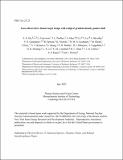Laser-direct-drive fusion target design with a high-Z gradient-density pusher shell
Author(s)
Hu, S.X.; Ceurvorst, L.; Peebles, J.L.; Mao, A.; Li, P.; Lu, Y.; Shvydky, A.; Goncharov, V.N.; Epstein, R.; Nichols, K.; Goshadze, R.M.N.; Ghosh, M.; Hinz, J.; Karasiev, V.V.; Zhang, S.; Shaffer, N.R.; Mihaylov, D.I.; Cappelletti, J.; Harding, D.R.; Li, Chi-Kang; Campbell, E.M.; Shah, R.C.; Collins, T.J.B.; Regan, S.P.; Deeney, C.; ... Show more Show less
Download23ja025_full.pdf (921.0Kb)
Metadata
Show full item recordAbstract
Laser-direct-drive fusion target designs with solid deuterium-tritium (DT) fuel, a high-Z gradient-density pusher shell (GDPS), and a Au-coated foam layer have been investigated through both 1D and 2D radiationhydrodynamic simulations. Compared with conventional low-Z ablators and DT-push-on-DT targets, these GDPS targets possess certain advantages of being instability-resistant implosions that can be high adiabat (α 8) and low hot-spot and pusher-shell convergence (CRhs ≈ 22 and CRPS ≈ 17), and have a low implosion velocity (vimp < 3 × 107 cm/s). Using symmetric drive with laser energies of 1.9 to 2.5 MJ, 1D LILAC simulations of these GDPS implosions can result in neutron yields corresponding to 50−MJ energy, even with reduced laser absorption due to the cross-beam energy transfer (CBET) effect. Two-dimensional DRACO simulations show that these GDPS targets can still ignite and deliver neutron yields from 4 to ∼10 MJ even if CBET is present, while traditional DT-push-on-DT targets normally fail due to the CBET-induced reduction of ablation pressure. If CBET is mitigated, these GDPS targets are expected to produce neutron yields of >20 MJ at a driven laser energy of ∼2 MJ. The key factors behind the robust ignition and moderate energy gain of such GDPS implosions are as follows: (1) The high initial density of the high-Z pusher shell can be placed at a very high adiabat while the DT fuel is maintained at a relatively low-entropy state; therefore, such implosions can still provide enough compression ρR >1 g/cm2 for sufficient confinement; (2) the high-Z layer significantly reduces heat-conduction loss from the hot spot since thermal conductivity scales as ∼1/Z; and (3) possible radiation trapping may offer an additional advantage for reducing energy loss from such high-Z targets.
Description
Submitted for publication in Physical Review. E, Statistical physics, plasmas, fluids, and related interdisciplinary topics
Date issued
2023-07Department
Massachusetts Institute of Technology. Plasma Science and Fusion CenterJournal
Physical Review. E, Statistical physics, plasmas, fluids, and related interdisciplinary topics
Publisher
APS
Other identifiers
23ja025